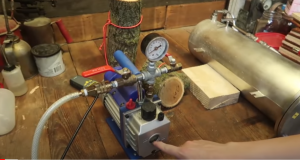Vacuum pumps are utilized in many technological devices, not just vacuum cleaners but other devices too. They work on various methods and have multiple uses concerning the device they are fitted in. However, the most important is fitting the vacuum pump correctly to achieve maximum efficiency as one has to look for various parameters while setting up a vacuum pump.
Here is all you need to know about the working of a vacuum pump.
An Overview of How a Vacuum Pump Works
A vacuum is a space that does not contain matter or is devoid of matter; hence, the basic target of a vacuum pump is to remove particles chemically or mechanically to achieve a vacuum. The vacuum achieved can either be a full vacuum or a partial vacuum.
It is a general characteristic of pressure molecules that move from an area of high-pressure molecules to an area of low-pressure molecules to maintain equilibrium. In this situation, vacuum pumps are employed, and they show anomalous behavior by moving the molecules or disrupting the equilibrium to create a vacuum or partial vacuum. The most important thing which should be considered is that the vacuum pump does not suck the air molecules; rather, it moves the air molecules.
How to Choose The Right Vacuum Pump
To choose the right vacuum pump, there are various factors you should take into consideration, such as lubrication, flow rate, chemical compatibility, and many more.
-
The Pump’s Flow Rate
One of the factors you should consider when choosing the right vacuum pump is the flow rate—the greater the flow rate, the lesser the drainage speed. The pump’s flow rate generally determines the mass flow speed as well as the pumping speed.
-
Lubrication
A lubricated vacuum pump is generally preferred over a dry vacuum in normal circumstances. The lubricated vacuum pump is generally more efficient and offers less resistance, but you have to maintain the lubricated vacuum pump regularly. In certain specific conditions, such as in laboratories, there are restrictions to using dry vacuum pumps only.
-
Chemical Compatibility
One of the most important chemical factors determining the type of vacuum pump you should choose is chemical compatibility. The gases in the vacuum pump system should be compatible with each other. Otherwise, they might create problems for your vacuum pump.
Types of Vacuum Pump
There are various types of vacuum pumps that are classified according to the place they are used in. However, the following are the general types of vacuum pumps.
-
Positive Displacement Pump
Positive displacement pumps are employed to create minimum to low pressure generally. The positive displacement pumps work by continuously expanding the cavity by following in on the gas molecules. After the cavity has expanded, they release the gas molecules in the air creating a low-pressure vacuum or low vacuum.
-
Momentum Transfer Pump
Momentum transfer pumps work together with positive displacement pumps, and they create a high-pressure vacuum. However, they work on a slightly different principle than of positive displacement pump.
Momentum transfer pumps, also called molecular pumps, work by using high-speed fluids to move gas from one area to another or outside the chamber.
-
Regenerative Pump
Regenerative pumps are the most complex type of vacuum pump. They work in the principle of hybrid theory. In addition to this, these pumps are used in a land lock and industrial processes. However, one of the drawbacks of the regenerative pump is that it requires extra power and energy.
-
Entrapment Pump
The entrapment pump is different from other types of pumps as it requires a cold temperature technique. Entrapment pumps use cold temperatures to compress gases and produce a hard residue.
Advantages of Vacuum Pump
Although vacuum pumps are employed in various machines and technological devices, they have advantages concerning every device. Here are the advantages of vacuum pumps.
- Vacuum pumps are used to dispose of and transport solid bio-waste materials safely through appropriate suction.
- They remove the wastage from the drainage efficiently and prevent clogged drainage.
- It also prevent the spillage and release of poisonous gases in the environment and offer timely suction.
Vacuum Pump in Vacuum cleaners
It also use vacuum pumps for their appropriate functioning. As we know, vacuum cleaning machines function by creating a vacuum, which is created by a vacuum pump.
Vacuum cleaners use four types of vacuum pumps for their functioning. These vacuum pumps include centrifugal blowers, turbine pumps, regenerative pumps, and positive displacement pumps. Each vacuum pump has its different features, and hence, each type of vacuum cleaner uses a different vacuum pump. For example, industrial vacuum cleaners use vacuum pumps which create a high vacuum to perform better suction.
Applications of Vacuum Pumps Used in Vacuum Cleaners
There are many applications of vacuum pumps, specifically those which help in the working of vacuum cleaners. Here are the most common applications of vacuum pumps.
- Vacuum pumps are used to absorb dangerous fumes and chemicals in the environment, and they help clean and purify the air, especially near the factories that cause air pollution.
- Vacuum pumps are also used to suck in the sparks, which are likely to cause a fire.
- Industrial vacuum cleaners employ high vacuum establishing vacuum pumps as they help maintain the air quality. The industries which use these pumps include the pharmaceutical industries and food and beverage industries.
- Vacuum pumps are generally employed for multiple uses in various industries such as the microelectronics industry, agriculture industry, automotive industry, pulp and paper industry, and many more.
Final Verdict
Conclusively, a simple working mechanism of a vacuum pump allows it to be used in various places and has multiple applications. However, the trickiest part is choosing the right type of vacuum pump for your vacuum cleaner. This depends on the purpose for which you want to use the vacuum cleaner.
We often see huge vacuum cleaners attached with factory and industry outlets; however, the size of the vacuum cleaner used in our households is much smaller and compact than those vacuum cleaners. Hence, choose the correct type of vacuum cleaner for your purpose.





